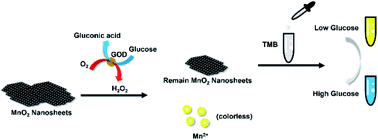Colorimetric glucose sensing with multiple-color changes by using a MnO2 NSs–TMB nanosystem†
Abstract
Glucose performs many essential functions associated with metabolic processes in the living system, and is closely related to many diseases such as diabetes and hypoglycemia. Most of the existing glucose concentration detection methods require complex instruments, which undoubtedly limit its widespread use. Here, we have designed a glucose colorimetric detection system composed of glucose, glucose oxidase (GOD), manganese dioxide nanosheets (MnO2 NSs) and 3,3′,5,5′-tetramethylbenzidine (TMB) to achieve colorimetric detection with the naked eye. Compared with the single-color change of the colorimetric method in previous studies, multiple-color changes have been realized. MnO2 NSs, as a kind of nanomaterial imitating oxidase, can directly oxidize TMB to oxTMB. Because oxTMB showed a dark yellow color when strongly oxidized and light blue when weakly oxidized, this feature can achieve multiple-color changes rather than a single-color change, which is helpful for colorimetric observation with the naked eye. Finally, we successfully used MnO2 NSs for colorimetric detection of glucose and realized multiple-color changes, making it easier to achieve colorimetric observation with the naked eye. The linear detection range is 0–4000 μM and limit of detection is 5.0 μM. This is not only useful for glucose, but also has an important significance for other experiments considering colorimetric experiments with the naked eye.



 Please wait while we load your content...
Please wait while we load your content...